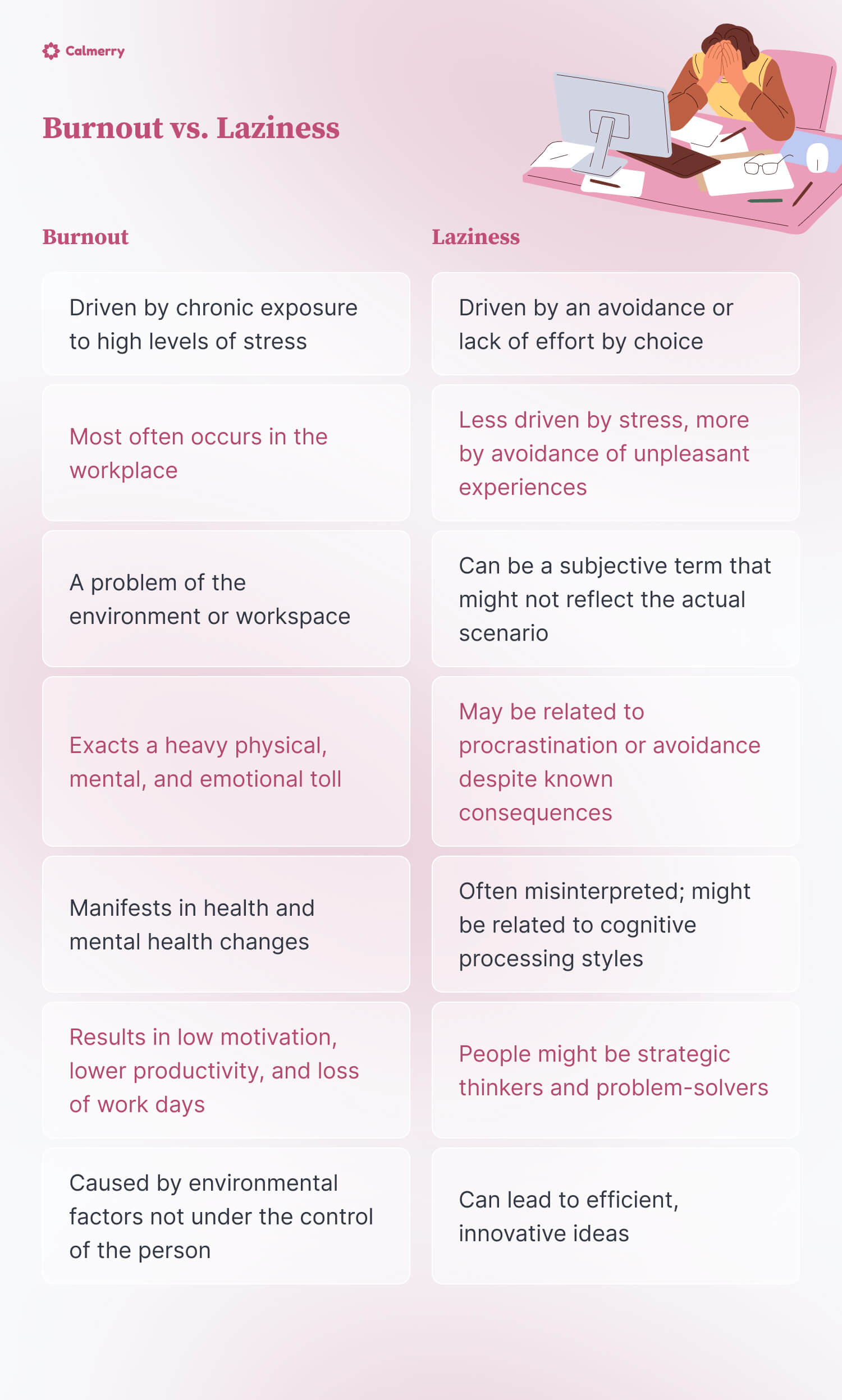Am I Burnt Out or Just Lazy?

In this article
Feeling like you can’t get anything done? Missing deadlines? Making to-do lists that just seem to keep getting longer – or lost?
At first glance, you might think that you’re just being lazy. We all find ourselves feeling that way sometimes. We all have those times when You. Just. Don’t. Feel. Like. It.
And, most of the time, it passes. That pile of “to-do’s” gets big enough that you can’t not deal with it. And just like that, we get back on track.
Sometimes though, that feeling of not wanting to or feeling unmotivated doesn’t pass. It feels like more than wanting to take a lazy day. You might find your mood is low. You might be feeling anxious or overwhelmed.
Are you just being a little lazy, or are you really burnt out? It’s not always easy to know which it is. Some experts even speculate that laziness isn’t really being “lazy” like we think of lazy but actually indicative of something more.
Whether it’s laziness or burnout, the difference matters.
Burnout vs. laziness
On the surface, burnout and laziness might sound similar. After all, both involve an avoidance of doing something. But there are significant differences to consider.
Burnout is driven by chronic exposure to high levels of stress, most often in the workplace. It is a problem of the environment or workspace.
Burnout exacts a heavy physical, mental, and emotional toll that manifests in changes in one’s health and mental health and functioning.
It can result in low motivation, lower productivity, increased dissatisfaction and engagement, and loss of work days. Burnout is the result of environmental factors that may not be under the control of the person.
Laziness, on the other hand, is considered to be more of an avoidance or lack of effort by choice. It seems to be driven less by stress and more by an avoidance of unwanted or unpleasant experiences.
However, laziness is a subjective term and may not reflect what’s really happening. It may be related to procrastination, avoiding something even knowing that there may be consequences for doing so.
And don’t write laziness off as inherently “bad.” Research has found that what might be seen as laziness might be more related to cognitive processing styles and a need for structured and reasoned ways of looking at things. [1] McElroy, T., Dickinson, D. L., Stroh, N., & Dickinson, C. A. (2016). The physical sacrifice of thinking: Investigating the relationship between thinking and physical activity in everyday life. Journal of Health Psychology. https://doi.org/10.1177/1359105314565827
– Dr. Dawn Ferrara, PsyD, Licensed Professional Counselor (LPC), and mental health writer
People with this way of thinking tend to be strategic thinkers and problem-solvers who can bring efficient, innovative ideas to the table.

What is laziness?
Laziness is generally defined as a disinclination towards or lack of personal effort. But defining laziness isn’t easy. It’s not a psychological term. It’s a lay term and a highly subjective term. What one person sees as being “easy going”, another may see as being “disinterested”.
Slacker…couch potato…clock watcher…deadbeat.
These terms, and others like it, have found their way into everyday language as a way of describing someone who is perceived as being lazy or unmotivated.
They carry a generally negative connotation and assumptions about the person being referenced:
- Unmotivated
- Unreliable
- Unorganized
- Content with doing as little as possible
Society tends to place a high value on hard work and perseverance, and that bias runs deep in our beliefs about work. Hard work has long been associated with one’s moral values and worth. [2] On the Insidious ‘Laziness Lie’ at the Heart of the American Myth. (2021, January 6). Literary Hub. https://lithub.com/on-the-insidious-laziness-lie-at-the-heart-of-the-american-myth/
Recent surveys have found that many people tend to have a bias towards seeing people as inherently lazy and needing to be pushed. [3] Pew Research Center. (2020, May 30). How Americans see other Americans. https://www.pewresearch.org/patriotic-honest-and-selfish-how-americans-describe-americans/
There’s a social stigma attached to being seen as lazy. We live in a fast-paced world that thrives on being productive, self-motivated, efficient, and organized.
When someone doesn’t meet that expectation, they are generally seen as incompetent or unreliable. Not traits one wants to be associated with and, traits that make having a successful career harder to achieve.
What are the causes of “laziness”?
Because laziness is more of a lay term, most research has looked at laziness through the lens of procrastination.
Science hasn’t been able to point to the one thing that might cause someone to behave in a way that might be defined as “lazy.”
Rather, there seems to be a number of factors that might be at play:
The brain
Brain studies have found evidence suggesting that the brain seems to be hard-wired to conserve energy, and more attuned to activities that require less physical exertion. [4] Cheval, B., Tipura, E., Burra, N., Frossard, J., Chanal, J., Orsholits, D., Radel, R., & Boisgontier, M. P. (2018). Avoiding sedentary behaviors requires more cortical resources than avoiding physical activity: An EEG study. Neuropsychologia, 119, 68–80. https://doi.org/10.1016/j.neuropsychologia.2018.07.029
Coping strategy
More than simply avoiding a task, laziness is often viewed through the lens of procrastination. Rather than being a time management issue, avoidance may be a way of coping with unpleasant feelings. [5] Alexander, E., & Onwuegbuzie, A. J. (2007). Academic procrastination and the role of hope as a coping strategy. Personality and Individual Differences, 42(7), 1301–1310. https://doi.org/10.1016/j.paid.2006.10.008
Age
It’s well-documented that parts of the brain responsible for executive functioning (e.g., decision-making, time management, organization) and longer-term thinking are still developing well into early adulthood.
During their developmental years, people tend to operate more on the need for pleasurable experiences and immediacy.
So, it’s not surprising that even young adults might be less inclined to act.
Personality
Certain personality traits like low conscientiousness or perfectionism may contribute to what might commonly be referred to as laziness. [6] Khosla, H. (2021). Academic procrastination and personality traits in college students. International Journal of Indian Psychology, 9(2). https://doi.org/10.25215/0902.129
Environment
Some behavior is learned. [7] Devaine M, Daunizeau J (2017) Learning about and from others’ prudence, impatience or laziness: The computational bases of attitude alignment. PLoS Comput Biol 13(3): e1005422. https://doi.org/10.1371/journal.pcbi.1005422 If others around you display “lazy” behaviors like blowing off work or school or not finishing work, you may adopt those behaviors, too.
Habit
Not getting things done might even be habitual for some. Successfully avoiding something unwanted or unpleasant can become rewarding over time.
Fatigue
The effects of fatigue have long been associated with a person’s motivation and workplace performance. When you’re tired, motivation and performance can suffer. [8] Rosekind, M. R., Gregory, K. B., Mallis, M. M., Brandt, S. L., Seal, B., & Lerner, D. (2010). The cost of poor sleep: workplace productivity loss and associated costs. Journal of Occupational and Environmental Medicine, 52(1), 91–98. https://doi.org/10.1097/jom.0b013e3181c78c30
There is growing evidence that “laziness” might not be what you think it is. What some consider being “lazy” might actually be the outer manifestation of something deeper.
Understanding burnout
Being “burnt out” is a term that has seeped into everyday language and is often used as a way to describe being tired or just kind of “over it.” But burnout is much more than that.
Burnout is a state of physical, emotional, or mental exhaustion resulting from exposure to prolonged or recurring stress. It is most often associated with workplace issues but can also result from chronic exposure to stressors in other areas of life. [9] APA Dictionary of Psychology. (n.d.). https://dictionary.apa.org/burnout
The World Health Organization (WHO) defines burnout, more specifically, as a syndrome resulting from workplace stress that has not been successfully managed.
It is characterized by three dimensions:
- Feelings of energy depletion or exhaustion
- Increased mental distance from one’s job or feelings of negativism or cynicism related to one’s job
- Reduced professional efficacy
Some of the common symptoms of burnout include:
- Feeling cynical or critical at work
- Dreading going to work or having trouble getting started
- Lacking energy or enthusiasm for your job or your accomplishments
- Becoming irritable or impatient with clients/customers or coworkers
- Feeling disillusioned about your job
- Boredom at work
- Using substances (e.g., food, alcohol) to cope
- Changes in sleep habits
- Experiencing unexplained headaches or other physical complaints
The prevalence of burnout
While it can happen to anyone, work burnout is particularly common in people in service-oriented professions, such as first responders, teachers, therapists, and medical professionals.
These professions report some of the highest rates of burnout and rates of suicide, which are significantly higher than those of the general public.
The pandemic certainly exacerbated this issue, and statistics suggest that burnout is still on the rise:
- A recent Indeed survey found that burnout continues to rise: 52% of all workers are feeling burned out, a 9% increase from a pre-COVID survey. [10] Employee Burnout Report: COVID-19’s impact and 3 Strategies to Curb it. (n.d.). https://www.indeed.com/lead/preventing-employee-burnout-report
- A 2022 McKinsey Health survey of 15,000 workers across 15 countries found that a quarter of employees experienced burnout symptoms. [11] Addressing employee burnout: Are you solving the right problem? (2022, May 27). McKinsey & Company. https://www.mckinsey.com/mhi/our-insights/addressing-employee-burnout-are-you-solving-the-right-problem
- A Deloitte survey found that 77% of workers have experienced burnout at their current job. Lack of support and recognition from leadership were cited as prime reasons for their experience. [12] Workplace Burnout survey. (n.d.). Deloitte United States. https://www2.deloitte.com/us/en/pages/about-deloitte/articles/burnout-survey.html
While numbers will vary, there’s no denying that burnout is a real concern and has an impact on the workplace and workplace mental health.
The impact of burnout
Burnout has a significant impact on the workplace. Not only does it impact the company’s success, but it also takes a high toll on employees both in terms of their productivity and their well-being.
Workplace stress and its effects are estimated to cost companies and the economy billions of dollars each year:
- Companies with high-pressure environments have 50% higher healthcare costs than other companies. [13] Azagba, S., & Sharaf, M. F. (2011). Psychosocial working conditions and the utilization of health care services. BMC Public Health, 11(1). https://doi.org/10.1186/1471-2458-11-642
- A recent report by the American Psychological Association estimates that about 550 million workdays are lost each year due to workplace stress and that the economy loses about 500 billion dollars annually to work-related stress. [14] Stress in America 2022. (n.d.). In https://www.apa.org. https://www.apa.org/news/press/releases/stress/2022/concerned-future-inflation
- Companies without adequate employee support systems were found to have higher turnover, lower productivity, and incur higher healthcare costs
Research [14] Stress in America 2022. (n.d.). In https://www.apa.org. https://www.apa.org/news/press/releases/stress/2022/concerned-future-inflation suggests that burned-out employees are:
- 2.6 times more likely to be actively seeking a new job
- 63% more likely to take a sick day
- 23% more likely to visit the emergency room for stress-related health issues
The WHO found that over 615 million people struggle with anxiety and depression worldwide, costing the global workforce an estimated $1 trillion annual loss in productivity. [15] Mental health in the workplace. (2023, October 21). https://www.who.int/mental-health-in-the-workplace
Strategies for overcoming burnout as an employee
So, if burnout is getting you down, is quitting your only option? Of course not! There are things you try to alleviate some of the distress.
1. Self-care
Lack of self-care is one of the primary drivers of burnout. It’s also something that we seem to struggle to find time for. It can feel like a luxury we don’t have time for. It might also be what you need most.
Self-care means doing things that nurture you physically, emotionally, mentally, socially, and spiritually. What that looks like for you will be different from someone else.
The important thing is to look for ways to incorporate self-care practices into your life. Prioritize the Big 3 – sleep, healthy meals, and regular exercise.
Feeling pressed for time? Start small. Something as simple as making time for a healthy meal or taking a few minutes for a morning meditation can be a healthy start.
2. Set healthy boundaries
Work-life balance is vital to managing stress. You need that time away from work to recharge and refresh. You can still be a team player and take care of yourself, too.
Setting boundaries can look like:
- Setting a clear beginning and ending for your workday. Avoid taking extra work home. This includes after-hours emails or phone calls.
- Using your break time to step away from your desk. Take a walk and get some fresh air.
- Taking your vacation!
- Learning to say no when you need to. It’s okay to let someone know your plate is already full. (This can apply to “life” too…you don’t have to accept every invitation or take on every request.)
3. Maintain social connections
Getting together with friends and family can seem like the last thing you have time for, but the connections you have are important.
Connecting with friends and family can boost your mood and increase feelings of well-being.
High levels of social support have been shown to increase resiliency, too, making you better able to deal with stressors. [16] Ozbay, F. (n.d.). Social support and resilience to stress: From neurobiology to clinical practice. PubMed Central (PMC). https://www.ncbi.nlm.nih.gov/pmc/articles/PMC2921311/
4. Ask for help
Asking for help is not a weakness. On the contrary, it is good self-care. If you find yourself struggling or feeling overwhelmed, reach out for help. That might look like a trusted friend, coworker, or even your boss.
Don’t assume that others can see your distress. And be specific. Ask for what you need. It’s okay, and it helps others know how to best support you.
Advice for employers on helping employees overcome burnout
Burnout is the proverbial “canary in the coal mine.” It is not a “people problem.” Burnout is a workplace problem that affects the people in it. It’s directly related to the work environment and issues that contribute to excessive load and stress.
– Dr. Dawn Ferrara, PsyD, Licensed Professional Counselor (LPC), and mental health writer
In a recent Gallup poll, employees surveyed identified their top five contributors to their burnout:
- Unfair treatment at work
- Unmanageable workload
- Lack of role clarity
- Lack of communication and support from management
- Unreasonable time pressure
These and other related findings speak to the need to create a workplace environment that is balanced in its expectations and supports every person on the team.
Every person can be an advocate for change and support. It starts with awareness and willingness to look at ways of nurturing a healthy workplace environment.
1. Recognize the signs
Being able to notice when one of your team is struggling is key. Burnout won’t look the same for every person, so knowing your team members can help you notice when something seems off, even if they’ve not said so.
A great way to get to know your team members is to talk to them. Get to know who they are and how they operate day-to-day. Ask how they’re doing. And listen.
If they’re struggling, it’s OK to ask, “How can I help?”
2. Support your employees in overcoming burnout
A leader leads by example. If you learn that someone on your team is struggling with burnout, step up to help.
- Ask how you can help.
- Encourage them to use available resources.
- Help them identify healthy workarounds or accommodations to ease some pressure.
- Be proactive in addressing problems.
- Encourage good self-care and work-life practices.
3. Promote a healthy, motivating environment
A healthy work environment is supportive and inclusive. Be proactive. Your employees will look to see if you simply “talk the talk” or actually “walk the walk.”
- Set clear boundaries and expectations for every person.
- Check-in with your team. What’s working? What’s not?
- Encourage team support for each other.
- Be an advocate for and model healthy workplace behaviors.
- Create safe spaces that can be used when needed, whether for a conversation or when an employee is feeling overwhelmed or dealing with a health/mental health issue (e.g., anxiety attack). Think of it as a place to take a few minutes to deal with whatever is happening so that they can return to their tasks and finish their day.
You can also promote a healthy working environment by advocating for policies, procedures, and resources that respect and support employees.
4. Encourage a culture of open communication
Employees need to know that it is safe to speak openly about their challenges and needs without fear of judgment or repercussions. They need to know it’s okay to ask for help, too.
- Normalize talking about mental health and workplace issues. Set clear expectations and model appropriate communication.
- Model being a safe person to reach out to for support. Seek out opportunities to connect and listen with compassion and concern.
- Have the conversations that everyone might be thinking about but not sure how to bring up. Let everyone know it’s ok to talk about the hard things.
- Have an open-door policy.
When someone comes with a problem, be proactive. Your response to a concern will send a clear message about the safety of speaking up and your trustworthiness as a resource.
5. Provide access to quality mental health care
Employee mental health has come to the forefront of workplace issues, especially in the wake of the pandemic.
Access to mental health services and resources is fast becoming one of those must-haves for a lot of employees and employers.
- If your company has mental health benefits or resources available, encourage their use. Be sure employees know how to access their benefits.
- If mental health benefits are not available, advocate for their inclusion in the employee benefits package.
- Share information on mental health resources whenever possible. A company newsletter or website are great options for sharing this information.
Let's connect
Book a 30-min demo call with us to learn more about our B2B offering and how Calmerry can help take the pressure off your team through flexible, customizable, and holistic therapy.
- See a live demonstration of how platform works
- Have an overview of our flexible payment models
- Get a tailored offer based on your company needs and number of employees
Therapy help when it’s needed
If you think that burnout may be keeping you from being at your best, help is available.
One of the biggest challenges people have when seeking help is knowing where to go and how to make time. If you’re working, there’s always the worry about taking time off for personal needs.
Online therapy has become a popular, easily accessible alternative to traditional in-office therapy. Sessions can be scheduled at times that work best and from the comfort of your home or other private location.
And most importantly, online therapy has proven to be as effective as in-office therapy.
At Calmerry, we believe that mental health care should be readily accessible when someone is in need. We have experienced therapists who understand the challenges of burnout and can help you to achieve a healthy work-life balance.
After a brief survey, you can be matched with a mental health professional within one hour and start therapy in one to two days. There’s no waiting weeks or months for an appointment. And there’s no complicated process to get started.
McElroy, T., Dickinson, D. L., Stroh, N., & Dickinson, C. A. (2016). The physical sacrifice of thinking: Investigating the relationship between thinking and physical activity in everyday life. Journal of Health Psychology. https://doi.org/10.1177/1359105314565827
On the Insidious ‘Laziness Lie’ at the Heart of the American Myth. (2021, January 6). Literary Hub. https://lithub.com/on-the-insidious-laziness-lie-at-the-heart-of-the-american-myth/
Pew Research Center. (2020, May 30). How Americans see other Americans. https://www.pewresearch.org/patriotic-honest-and-selfish-how-americans-describe-americans/
Cheval, B., Tipura, E., Burra, N., Frossard, J., Chanal, J., Orsholits, D., Radel, R., & Boisgontier, M. P. (2018). Avoiding sedentary behaviors requires more cortical resources than avoiding physical activity: An EEG study. Neuropsychologia, 119, 68–80. https://doi.org/10.1016/j.neuropsychologia.2018.07.029
Alexander, E., & Onwuegbuzie, A. J. (2007). Academic procrastination and the role of hope as a coping strategy. Personality and Individual Differences, 42(7), 1301–1310. https://doi.org/10.1016/j.paid.2006.10.008
Khosla, H. (2021). Academic procrastination and personality traits in college students. International Journal of Indian Psychology, 9(2). https://doi.org/10.25215/0902.129
Devaine M, Daunizeau J (2017) Learning about and from others’ prudence, impatience or laziness: The computational bases of attitude alignment. PLoS Comput Biol 13(3): e1005422. https://doi.org/10.1371/journal.pcbi.1005422
Rosekind, M. R., Gregory, K. B., Mallis, M. M., Brandt, S. L., Seal, B., & Lerner, D. (2010). The cost of poor sleep: workplace productivity loss and associated costs. Journal of Occupational and Environmental Medicine, 52(1), 91–98. https://doi.org/10.1097/jom.0b013e3181c78c30
APA Dictionary of Psychology. (n.d.). https://dictionary.apa.org/burnout
Employee Burnout Report: COVID-19’s impact and 3 Strategies to Curb it. (n.d.). https://www.indeed.com/lead/preventing-employee-burnout-report
Addressing employee burnout: Are you solving the right problem? (2022, May 27). McKinsey & Company. https://www.mckinsey.com/mhi/our-insights/addressing-employee-burnout-are-you-solving-the-right-problem
Workplace Burnout survey. (n.d.). Deloitte United States. https://www2.deloitte.com/us/en/pages/about-deloitte/articles/burnout-survey.html
Azagba, S., & Sharaf, M. F. (2011). Psychosocial working conditions and the utilization of health care services. BMC Public Health, 11(1). https://doi.org/10.1186/1471-2458-11-642
Stress in America 2022. (n.d.). In https://www.apa.org. https://www.apa.org/news/press/releases/stress/2022/concerned-future-inflation
Mental health in the workplace. (2023, October 21). https://www.who.int/mental-health-in-the-workplace
Ozbay, F. (n.d.). Social support and resilience to stress: From neurobiology to clinical practice. PubMed Central (PMC). https://www.ncbi.nlm.nih.gov/pmc/articles/PMC2921311/
online therapy
live video session




